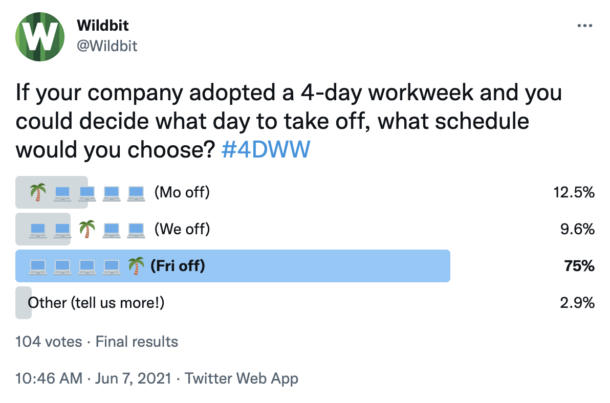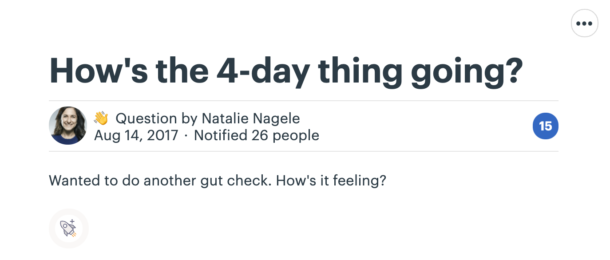
If you’re part of a team who is deciding to join the growing ranks of companies running on a 4-day workweek, you have to make an important decision: Which day should you cut from the work schedule?
While this sounds like a simple question, deciding which day to take off is almost as big a decision as the choice to transition to a 4-day week in the first place. Finding a schedule that works for your business, team, customers, and partners is crucial to make the 4-day week a success.
In this post, we’ll explore the different ways you can structure your 4-day workweek, with the benefits and drawbacks of the different approaches; we’ll also look at four real-world examples of companies that have adopted 4-day workweeks and, more importantly, why they chose the days they did.
Fixed day vs. flexible 4-day workweeks: Which is better?
There are two main approaches to implementing a 4-day workweek: taking the same day off every week or keeping the schedule flexible and taking a different day off from one week to the next. Both approaches have benefits and disadvantages. Let’s take a look.

Pros and cons of a 4-day workweek with a fixed day off
If you’re opting for a fixed-day-off approach, you’ll settle on a specific day as the extra day off for all your team members. A fixed day off helps maintain a consistent routine: everybody—your team, your customers, your partners—knows exactly what to expect, and it’s easy to schedule cross-functional meetings.
When we conducted an informal poll on Twitter and LinkedIn to determine which days people would prefer to take off, Fridays were the overwhelming winner:

Of course, a 4-day workweek with a fixed day off can be challenging for customer support and customer-facing teams who want (or need) to be available throughout the week. This is why many customer success teams end up taking a staggered approach, in which some team members cover one part of the week and others cover the remaining days to ensure continuous availability.
Another downside to the fixed-day-off approach is that it doesn’t allow for much spontaneity. Sometimes, a day off mid-week can be really handy for running unexpected errands or taking care of personal obligations on the fly. So if your ultimate goal for introducing a 4-day workweek is to maximize flexibility, a fixed day off may not be the right decision.

Pros and cons of a 4-day workweek with a flexible day off
With a flexible 4-day workweek, team members can choose their free day flexibly and spontaneously. You’d like to spend this Monday with your family to celebrate a birthday, but next Monday you’re working heads-down on a project and are taking Friday off instead? A flexible 4-day week makes this possible.
This approach is ideal for companies and teams that prioritize flexibility above anything else. But the flexibility that’s great on an individual level can bring its own challenges for the larger team: if everyone takes different days off, and schedules change from week to week, this approach can be confusing and complicated. Scheduling meetings with different team members can become difficult, as it’s harder to stay on top of who’s available when. Plus, team members who prefer predictable schedules to optimize their deep work times may find this approach disruptive.
How have other companies structured their 4-day workweek?
We know several companies, ourselves included, that have been engaged in a lot of experimentation with 4-day workweeks to see what works best… and this means you can learn from our trial and error and see the real-world impacts of choosing specific days for your third day off every week.
Wildbit: Fridays off (with an exception)
We first cut Fridays from our workweek in May 2017, and what started as an experiment simply never stopped.
Why Fridays? One of the major drivers for this choice was our focus on the concept of deep work. We believe that creating space for deep, focused work is vital to the success of our business, and a fully flexible approach or a mid-week break would make optimizing for deep work a whole lot harder. We also knew we wanted to give our team three consecutive days of rest—and since Monday historically is one of the busiest days for our Customer Success team, we chose Friday as our primary day off for the team.

“Deep, focused work doesn’t work if you don’t have the other partner to it: Rest. And we realized that our current two-day weekends weren’t really cutting it. Most of us don’t fully disconnect. We spend our weekend being weekend warriors. And by Sunday night, we’re all still exhausted.
So we started dropping one full day so we can have four days of deep work and three consecutive days of rest to recharge. Now, Mondays are no longer grueling. A lot of us feel energized coming on Monday because we had a three-day break. Our brains really rested.”
— Natalie Nagele, CEO at Wildbit
The only exception to our fixed Fridays-off approach is our Customer Success team. To make sure that our customers can reach us all week, we have a part of the team covering Tuesday-Friday. That way, everyone can enjoy a three-day weekend while still making sure our customers can reach us throughout the workweek.
The Wanderlust Group: Mondays off
Outdoor travel technology company The Wanderlust Group (TWG) chose Mondays as its third day off in June 2020.
Many of TWG’s customers are campgrounds and marinas. For recreational businesses, Fridays are typically very busy, which ruled out Fridays; instead, TWG chose Mondays as its third day off to give employees more breathing room to prepare themselves for their workweek.

“I’ve heard from team members that having Monday to themselves—with no family obligations and no work obligations—gives them time to think heading into the week. Whereas Friday acts as a jumpstart into the weekend, Monday can give people the mental break to start off their weeks strong.”
Welcome to the Jungle: Flexible initially, Wed/Fri today
Welcome to the Jungle, a media and technology recruitment consultancy headquartered in Paris, went to great lengths to quantify, test, and evaluate its approach to a 4-day workweek between June and October of 2019 (we recommend reading their 82-page booklet.)
Initially, the consultancy adopted a flexible approach: employees were given the choice to take any day of the week off with the exception of Mondays, which remained a mandatory workday for team meetings.
However, it soon became apparent that the approach wasn’t working:

“During the first months, it was a real mess: it was impossible to know who was off when, impossible to plan a meeting and synchronize agendas… We were less efficient and less reactive.”
After examining the data from five months of experimentation, the team found that Wednesdays and Fridays were by far the most popular choices: 25% of employees chose Wednesdays, and 50% chose Fridays as their day off. So Welcome to the Jungle decided that employees could choose between Wednesdays or Fridays for their third day off, a structure that remains in place at the agency today.
VERSA: Wednesdays
Conversational artificial intelligence (AI) agency VERSA, which is headquartered in Melbourne, introduced a 4-day workweek in 2019.
Rather than experiment with different days, the company chose to give all employees Wednesdays off, a schedule that continues to this day. The reasoning for doing so was to give employees a break in the middle of the week to spend time with their families and take care of mid-week errands, but also to approach the remainder of the week with renewed focus.

“Rather than creating a long weekend, a break in the middle of the week also means they can get on top of work by Tuesday afternoon and hit the ground running on Thursday morning. This allows for staff to spend time with their families, whilst also remaining on top of work for the duration of the week.”
Buffer: Flexible initially, Fridays today
Social media management platform Buffer first introduced a 4-day workweek in May 2020. The team had long suspected that the traditional five-day week wasn’t the best approach to the workweek, and COVID-19 gave it an opportunity to test its hypothesis while also accommodating employees who were navigating the stress and uncertainty of the pandemic.
Initially, Buffer gave individual teams the freedom to choose their own third day off each week; this offered individual teams a lot of flexibility, but it created the same problems with meetings and collaboration between cross-functional teams that Welcome to the Jungle had also experienced.
Ultimately, Buffer settled on Fridays for the third day, with the exception of the Customer Advocacy (CA) team, which rotates its third day due to Buffer’s 24/7 support service. To determine which days support staff worked, Buffer asked the CA team which days they preferred to take off and created a system that maximized the number of people who could enjoy a three-day weekend while ensuring continuity of support and regular scheduling for those employees:

How should you decide which extra day to take off?
No two companies’ needs are exactly alike, and what works well for one company may not do so for another. There are, however, several steps you can take to identify the best additional day to take off in ways that benefit your company, your customers, and your team.
1. Define your goals
Reducing the workweek by 20% should be a goal-oriented decision. It’s vital to examine why you’re considering transitioning to a 4-day week—and then picking a schedule that best supports your goals.
The examples above show how different goals and priorities can result in very different schedules. Some companies, including Wildbit, optimize their 4-day workweeks around rest, whereas VERSA wanted to create the energized Monday-buzz two times a week. This is why setting tangible goals before making any firm decisions is crucial.
2. Involve your team in the process
While your team will likely be thrilled to hear about plans for a 4-day workweek, not everyone will agree on the best day to cut from the schedule. Before you finalize your decision, ask the team about their preferences and concerns: you can then use this information to design the first iteration of your new 4-day schedule.
There are different ways to invite this kind of initial input, including:
- A company-wide discussion during an all-hands meeting
- An informal Slack poll
- An anonymous survey
- A working committee
Encourage everyone on the team to add their input, and allow people to voice their opinions in ways that align with how they prefer to communicate. The more responses you have to work with, the greater the likelihood of arriving at a decision that satisfies as many people as possible.
3. Ask for feedback early and often
Several of the companies featured above approach the 4-day workweek as an ongoing experiment, and some have adjusted their schedules over time. This is normal: what may have seemed like a good idea initially might turn out not to be as practical several weeks into the new routine—which is why soliciting feedback early and often is important to understand what’s working and make adjustments if needed. Find the feedback channels that work best for your team, whether that’s a regular check-in via email, an anonymous survey, or encouraging your team to share feedback with their managers.

4. Keep your customers and business partners in mind
Transitioning to a 4-day workweek isn’t just a major shift for you and your employees: it’s a change for all constituents, including your customers and business partners, too.
However you choose to structure your experiment, know that a reduced workweek will impact customer operations and working with partners and vendors. This might mean implementing team-specific exceptions to ensure continuity of support (as Buffer and Wildbit did), having uncomfortable conversations with partners, or having to find a new routine for working with vendors. Framing those discussions in the context of your goals may make it easier for partners to understand the rationale behind your decision.
What else would you like to learn about implementing the 4-day workweek?
Are you interested in exploring a 4-day week for your team but aren’t sure where to start? We’re here to help you start your 4-day journey on the right track. Join us for our upcoming webinar on September 1 and ask leaders from the teams who’ve already made the switch to a shorter week all your burning questions.

